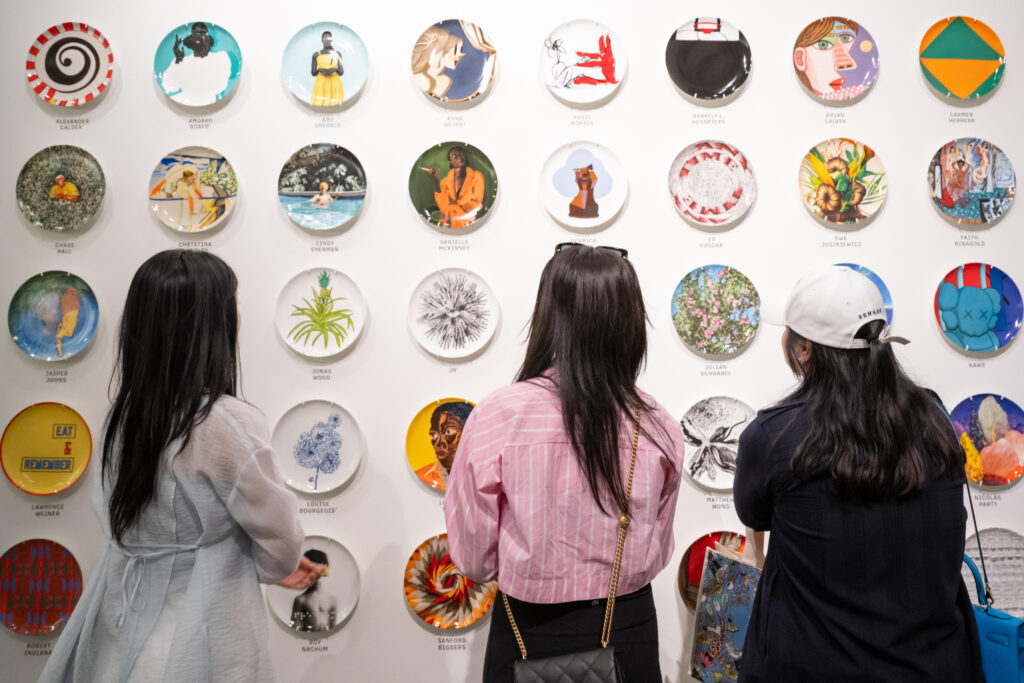“I’ve been at fancy dinners in the Hamptons with a full table of them set for forty people.” – Michelle Hellman

It’s New York Art Week and the Artist Plate Project from the Coalition for the Homeless is the hot ticket in town—if the ticket were a limited-edition porcelain plate by a blue-chip heavyweight artist. JANET MERCEL catches up with founder and curator MICHELLE HELLMAN at Frieze.
While VIP previewers at The Shed ogle Jeff Koons’ new $3 million-plus Hulk sculptures and a Tracey Emin piece topped at $1.5 million (per Artsy), an equally coveted sale—with just as much splash for a fraction of the cash—is going on under our noses down the corridor.
As expected, fair goers line up to get their hands on the coveted fine-bone china dinner plates, each designed with work from a world-class artist, released in editions of 250. At $250 a pop, they are—quite by intention—one of the most democratic and accessible buys of the week. The first 100 plates are reserved for Frieze, while the remaining editions drop online tomorrow to the fastest buyers (set your timers, they sell out in fractions of a second). Since 2020, the plates have featured over 150 artists and raised over $7 million to provide food, clothing, financial and crisis aid, and youth programs to homeless New Yorkers.
In the project’s fourth launch, there are 50 editions—the most artists ever offered—including Alexander Calder, Amoako Boafo, Amy Sherald, Jasper Johns, Jean-Michel Basquiat, Lorna Simpson, Louise Bourgeois, and Takashi Murakami. The lineup spans decades of modern and contemporary art, so you’ll find a 1988 Robert Mapplethorpe or a 1969 Barkley Hendricks alongside an Anna Weyant or Danielle Mckinney from last year—which means fun, fun, fun for collectors.
Underneath the colorful installation of dozens of plates at Frieze, stacked Fornasetti-style up the wall, curator Michelle Hellman’s high heels and even higher-wattage smile are on full blast.

Everyone wants to buy an artist plate.
Buyers calling to try and get early access and all that. I feel bad saying no to people, but everyone must wait until the sale starts on the first day.
How did all this get started?
In 2019, I was on the board of Coalition for the Homeless. The annual fundraiser, ARTWALK, is a big night out for the younger attendees—it’s a big deal just to buy a ticket. There’s a silent auction and live lots, and they can’t afford to buy any of that $5,000 to $100,000 artwork. We wanted something for those younger supporters. For the 25th ARTWALK, Katherine Bernhardt was being honored. We made an edition of 100, and they went quick. Her plate kicked it off.
“The purchase of just one plate can feed more than 100 homeless and hungry people.” – Michelle Hellman
Why plates?
I was volunteering to feed the homeless – helping to serve plates of food out of vans. A literal plate just felt like a nice, holistic, 360-degree tie-in. When Covid hit, I thought let’s blow that concept out and ask every artist we can. And now we can say that the purchase of just one plate can feed more than 100 homeless and hungry people.
There’s always been a particular connection between visual artists and social impact. And now, you’re making high-end art more available to a broader demographic—which, in turn, goes back to cultural assistance. It’s a nice conversation about circularity in the art world.
The simplicity of the ask makes it possible; that’s another reason why this evolved without becoming too much of a burden. The saddest part is that artists donating work can’t write off anything, while collectors can write off whatever they want. That’s a whole other conversation.
What’s it like dealing with all those high-profile artists and artist estates? How do you decide what work ends up on a plate?
They’re the easiest part. These artists are so in demand, and they’re constantly being asked—by every cause under the sun—to create and donate work for auctions. The plates don’t take up too much of their time or energy because it’s based on existing work. All I need is a high-res image and a digital signature. I used to take whatever I could get, but it’s done so well now I get a little gutsy about asking for something.
With how competitive it’s become to buy a plate; do you still feel like the original intent is intact—accessible ownership and a wider entry point to collecting?
It became so popular so quickly and impacted more established collectors and all demographics. But it touches everyone, and there’s no back door. It’s first come, first served. My favorite thing is seeing a young college student who has one displayed on their shelf in their dorm, as much as a major collector who has an installation wall in their home. It’s a total mix.
Do you eat off your plates?
Yeah, I eat off my plates! All the time. And I’ve been at fancy dinners in the Hamptons with a full table of them set for forty people.
What are your other highlights for this year’s Art Week?
My husband [Adam Cohen, A Hug From The Art World founder] is showing at Independent [art fair] so we’ll be juggling back and forth from there and Frieze. And my good friend Marlies Verhoeven is celebrating 10 years of co-founding The Cultivist, so that’s exciting.


